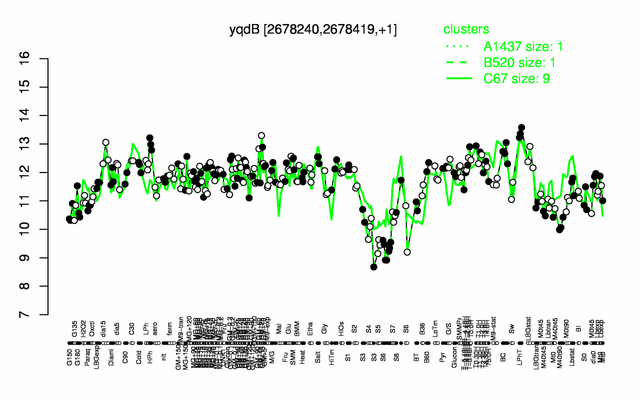Difference between revisions of "TxpA"
| Line 58: | Line 58: | ||
=== Additional information=== | === Additional information=== | ||
| − | |||
| − | |||
| Line 114: | Line 112: | ||
* '''Additional information:''' | * '''Additional information:''' | ||
| + | ** next to ''[[yonT]]'', the ''[[txpA]]'' mRNA has the strongest Shine-Dalgarno region in ''B. subtilis'' {{PubMed|19210617}} | ||
=Biological materials = | =Biological materials = | ||
| Line 137: | Line 136: | ||
=References= | =References= | ||
| − | <pubmed>16166525, </pubmed> | + | <pubmed>16166525, 19210617 </pubmed> |
[[Category:Protein-coding genes]] | [[Category:Protein-coding genes]] | ||
Revision as of 14:39, 17 July 2012
- Description: toxic peptide
| Gene name | txpA |
| Synonyms | yqcR, yqdB |
| Essential | no |
| Product | toxic peptide |
| Function | toxin |
| MW, pI | 6 kDa, 8.139 |
| Gene length, protein length | 177 bp, 59 aa |
| Immediate neighbours | yqbN/2, ratA |
| Get the DNA and protein sequences (Barbe et al., 2009) | |
Genetic context 
This image was kindly provided by SubtiList
| |
Expression at a glance PubMed
| |
Contents
Categories containing this gene/protein
toxins, antitoxins and immunity against toxins, Skin element, membrane proteins
This gene is a member of the following regulons
The gene
Basic information
- Locus tag: BSU26050
Phenotypes of a mutant
Database entries
- DBTBS entry: [1]
- SubtiList entry: [2]
Additional information
The protein
Basic information/ Evolution
- Catalyzed reaction/ biological activity:
- Protein family:
- Paralogous protein(s):
Extended information on the protein
- Kinetic information:
- Domains:
- Modification:
- Cofactor(s):
- Effectors of protein activity:
- Localization:
- cell membrane
Database entries
- Structure:
- UniProt: P54373
- KEGG entry: [3]
- E.C. number:
Additional information
Expression and regulation
- Operon: txpA PubMed
- Regulation:
- Additional information:
Biological materials
- Mutant:
- Expression vector:
- lacZ fusion:
- GFP fusion:
- two-hybrid system:
- Antibody:
Labs working on this gene/protein
Richard Losick, Harvard University, Cambridge, USA Homepage
Your additional remarks
References